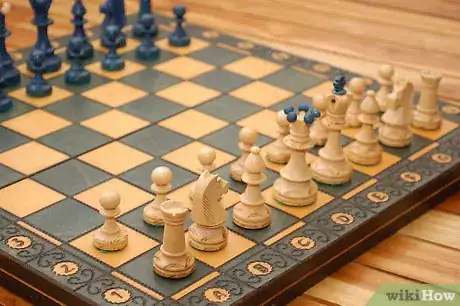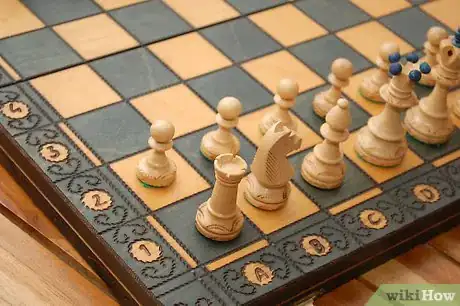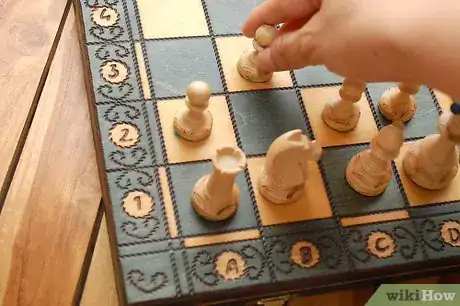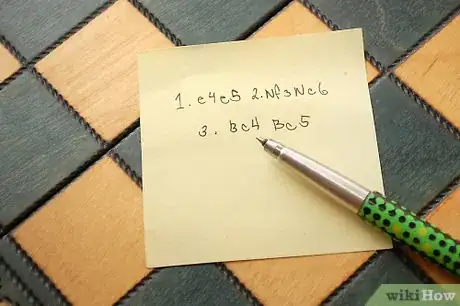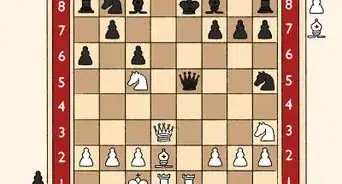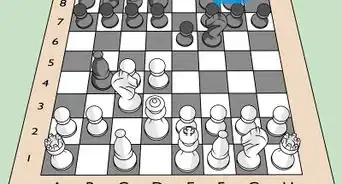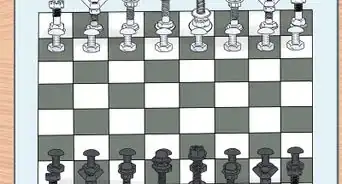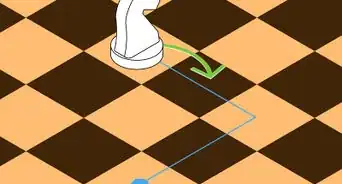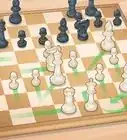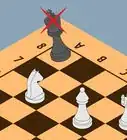This article was co-authored by Sahaj Grover. Sahaj Grover is a Chess Grandmaster, World Champion, and coach, who attained his Grandmaster title at the age of 16. He has been a World Junior Bronze Medalist, World U10 Champion, South African Open 2017 & 2018 Champion, and the Winner of the Arnold Classic 2018 & 2019. Sahaj is known for dynamic attacking skills and being an excellent endgame player.
There are 11 references cited in this article, which can be found at the bottom of the page.
wikiHow marks an article as reader-approved once it receives enough positive feedback. In this case, 100% of readers who voted found the article helpful, earning it our reader-approved status.
This article has been viewed 209,609 times.
Algebraic chess notation, based on a system introduced by Philipp Stamma,[1] is a system for recording chess movements. Being more concise and less ambiguous, algebraic chess notation has become the standard method for recording chess moves, replacing the once popular system of descriptive chess notation.
If you are serious about chess, it is very important to learn how to read and use algebraic chess notation correctly, so you can enjoy the vast amount of chess literature available and study your own games. Many tournaments require you to take notation, and it is for your benefit during post-game analysis so you can improve your game. This article will show you how to read, write, and understand algebraic chess notation.
Steps
-
1
-
2Learn how the squares are named. There are 64 squares on the chessboard (32 white, 32 dark), and each one has a unique name denoted by the algebraic chess notation:[3]
- The vertical files (columns) are labeled A through H, starting from left to right on White's side;
- The horizontal ranks (rows) are numbered 1 through 8, starting from bottom to top on White's side.
- A given square on the chessboard is denoted by the lowercase file (column) letter, followed by the rank (row) number. For example, g5 is the square corresponding to the file g and rank 5.[4]
Advertisement -
3Learn how each piece is denoted. Usually, each chess piece is denoted by the first letter of its name in uppercase, except for the knight (which uses an "N") and the pawn (nothing). For figurine algebraic notation, a specific symbol is used for each piece.[5]
- King = K or ♔ or ♚
- Queen = Q or ♕ or ♛
- Rook = R or ♖ or ♜
- Bishop = B or ♗ or ♝
- Knight = N (since K is already taken by the king) or ♘ or ♞
- Pawn = (no letter) -- pawns are denoted by the absence of a letter or ♙ or ♟
-
4Learn how to write the notation for conventional moves.[6]
- Label the move number first. Each pair of moves is prefaced by a number followed by a period which indicates the ordinal number of the pair of moves - i.e., 1. for the first pair of moves (white, then black0, 2. for the second pair of moves, and so on.
- Write white's move after the move number and follow it with black's move, one pair of moves per line according to the following conventions:
- Denoting a move to an open square: Write the capital letter which designates the piece, followed by the coordinate of the destination square. For example, a knight going to the square f3 would be denoted as Nf3; a pawn going to the square e4 would be denoted simply as e4. (Remember that pawns do not get a letter).
- Denoting a capture:. Each capture move is denoted by the letter of the piece, followed by a lowercase x, then the coordinate of the destination square.[7] For example, a bishop capturing a piece at c4 would be denoted as Bxc4. Sometimes, the x will be omitted.
- When a pawn makes a capture, the file (column) from which the pawn departed is used in place of a piece initial. Thus, a pawn on e4 captures a piece on d5 would be denoted as exd5, or simply ed5 as the x is sometimes omitted.
- En passant moves are denoted by the file (column) of departure of the capturing pawn, followed by the square to which it moves, followed, optionally, by the abbreviation "e.p.". Thus, a pawn on e5 capturing en passant a pawn on d5 is denoted as exd6 or exd6 e.p..
-
5Learn how to write special situations.[8]
- If two or more identical pieces can move to the same square, the letter for the piece is followed by:
- the file (column) of departure if they differ;
- the rank (row) of departure if the files are the same but the ranks differ;
- both the rank and file if neither alone uniquely defines the piece.
- For example, if two knights on d2 and f2 can both reach e4, the move is denoted as Nde4 or Nfd4, as appropriate. If two knights on d2 and d6 can both reach e4, the move would be denoted as N2d4 or N6d4, as appropriate. If three knights on d2, d6, and f2 can all reach e4, with capture, the move would be denoted as Nd2xe4, N6xe4, or Nfxe4, as appropriate.
- For pawn promotion, the piece to which it is promoted is written after the destination coordinate. For example, a pawn on e7 moving to e8 and promoting to a knight would be denoted as e8N. Sometimes an equal sign (=) is used, as in e8=N, or parentheses are used, as in e8(N), or a slash (/) is used, as in e8/N. Only the first type is used in FIDE standard.[9]
- For castling, O-O denotes king side castle, while O-O-O denotes queen side castle.
- A check is denoted by + after the move notation; double check may be denoted by ++ (keep in mind that some use "++" to signify checkmate as well and many will simply write double check with a single "+".
- Checkmate is denoted by # after the move notation. Some older chess literature may denote ++ as checkmate.
- A 1-0 is used at the end of the game to denote a white win, 0-1 to denote a black win, and ½-½ (or 0.5-0.5) to denote a draw. The words "White Resigns" or "Black Resigns" may be used to denote a resignation.
- If two or more identical pieces can move to the same square, the letter for the piece is followed by:
-
6Learn the punctuation that is used for commentary on the moves.
- Punctuation is commonly used to comment on the effectiveness of moves, usually relative to the skill of the player. It is placed after the move. For example:[10]
- ! a good move
- !! an excellent move
- ? a questionable move
- ?? a blunder
- !? an interesting move but unclear
- ?! a dubious move but worth considering
- Punctuation is commonly used to comment on the effectiveness of moves, usually relative to the skill of the player. It is placed after the move. For example:[10]
-
7Learn how to put it all together. List of moves are denoted as numbered pairs by White followed by Black.[11] For example, 1. e4 e5 2. Nf3 Nc6 3. Bc4 Bc5.
- Moves may be interrupted by comments. When the record resumes with a Black move, an ellipsis (…) takes the place of the White move. For example: 1. e4 e5 2. Nf3 Black now defends his pawn. 2...Nc6.
Community Q&A
-
QuestionWhat is the knight called in ancient texts?
 Awesome96BirdyCommunity AnswerIn Shatranj, an ancient predecessor of chess, it was called an "asb." However, there were many different ancient types of chess, so there were many different names for a knight.
Awesome96BirdyCommunity AnswerIn Shatranj, an ancient predecessor of chess, it was called an "asb." However, there were many different ancient types of chess, so there were many different names for a knight. -
QuestionI've seen many types of chess notation. What is the most common/official type of notation?
 Dennis ColakCommunity AnswerRight now, the most common is an algebraic notation, such as 1. Nf3, but you also might sometimes see the descriptive notation, such as 1. KN-B3, or 1. Kt-B3. This means the Knight on the kingside moves to the 3rd rank on the bishop's file.
Dennis ColakCommunity AnswerRight now, the most common is an algebraic notation, such as 1. Nf3, but you also might sometimes see the descriptive notation, such as 1. KN-B3, or 1. Kt-B3. This means the Knight on the kingside moves to the 3rd rank on the bishop's file.
Things You'll Need
- Chess set (optional)
- Paper or software for practice
References
- ↑ https://en.wikipedia.org/wiki/Philipp_Stamma
- ↑ https://www.chess.com/article/view/how-to-set-up-a-chessboard
- ↑ https://www.chess.com/article/view/chess-notation
- ↑ Sahaj Grover. Chess Grandmaster. Expert Interview. 4 May 2021.
- ↑ http://blog.chesshouse.com/how-to-read-and-write-algebraic-chess-notation/
- ↑ https://www.expert-chess-strategies.com/chess-notation.html
- ↑ Sahaj Grover. Chess Grandmaster. Expert Interview. 4 May 2021.
- ↑ https://www.dummies.com/games/chess/how-to-notate-special-events-in-chess/
- ↑ http://www.fide.com
